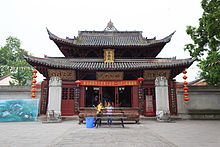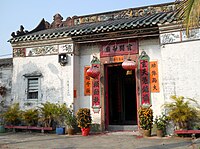| Heidi | |
|---|---|
 Diagram of the
Wufang Shangdi | |
| Major cult centre | Mount Heng |
| Predecessor | Baidi (Wuxing cycle) |
| Successor | Cangdi (Wuxing cycle) |
| Planet | Mercury |


| Part of a series on |
| Chinese folk religion |
|---|
 |
Hēidì ( Chinese: 黑帝; lit. 'Black Deity') or Hēishén (黑神; 'Black God'), who is the Běidì (北帝; 'North Deity', Cantonese: Pak Tai) or Běiyuèdàdì (北岳大帝; 'Great Deity of the Northern Peak'), is a deity in Chinese religion, one of the cosmological " Five Forms of the Highest Deity" (五方上帝; Wǔfāng Shàngdì). He is also identified as Zhuānxū (颛顼), today frequently worshipped as Xuánwǔ (玄武; 'Dark Warrior') or Zhēnwǔ (真武), and is associated with the essence of water and winter. His animal form is the Black Dragon and his stellar animal is the tortoise-snake. [1] By virtue of his association with the north, he has been identified and revered frequently as a representation of the supreme God of Heaven.
His planet is Mercury. His animal form is the Black Dragon and his stellar animal is the tortoise-snake. [2] [3]
Taoist myths involving the Black Deity
A Taoist title of Heidi is the "Dark (or Mysterious) Heavenly Highest Deity" (玄天上帝; Xuántiān Shàngdì). According to a myth, during the fall of the Shang, the Demon King ravaged the world, so that Yuanshi Tianzun ordered the Jade Emperor to appoint Heidi as the commander of twelve heavenly legions to fight this evil. Heidi defeated the Demon King and was subsequently granted the title of Mysterious Heavenly Highest Deity. In temples dedicated to him, the bronze tortoise and serpent under the feet of his image signify that the good always prevails over evil. [4]
Festivals
- The day for celebration of Heidi across China is his birthday, on lunar April 21.
- A festival is held on the island of Taipa in Macau. The celebration at the Pak Tai Temple includes an opera-styled performance
- Annual Bun Festival in Cheung Chau Island, Hong Kong, held in front of the Pak Tai Temple.
Temples in Hong Kong
In Hong Kong, it is worshipped among other places in:
Note : A territory-wide grade reassessment of historic buildings is ongoing. The grades listed in the table are based on these updates [1] [2] (8 June 2023). The temples with a "Not listed" status in the table below are not graded and do not appear in the list of historic buildings considered for grading.
| Location | Notes | Status | References | Photographs |
|---|---|---|---|---|
| No. 2 Lung On Street,
Wan Chai |
Wan Chai Pak Tai Temple (灣仔北帝廟), also known as Yuk Hui Kung (玉虛宮) Managed by the Chinese Temples Committee. |
Declared | [3] [4] [5] |  |
|
A Kung Ngam, south coast of
Lei Yue Mun Channel |
Pak Tai Temple The inscription at the front reads 北帝契爺. |
Not listed | [6] [7] [8] [9] |  |
| Near the southern junction of Old Main Street Aberdeen and Aberdeen Main Street,
Aberdeen |
Pak Tai Temple Part of the "Guardians of Aberdeen" group of small temples and shrines. |
Not listed | [10] [11] |  |
| Facing
Stanley Bay,
Stanley |
Pak Tai Temple, Stanley (赤柱北帝廟) Built in 1805. Managed by Stanley Kai-fong Welfare Association Ltd. by delegation from the Chinese Temples Committee. |
Nil grade | [12] [13] [14] [15] [16] [17] [18] |  |
|
Hok Tsui Village (鶴咀村),
D'Aguilar Peninsula |
Pak Tai Temple | Not listed | [19] |  |
| No. 146
Ma Tau Wai Road,
Hung Hom |
Pak Tai Temple, Hok Yuen Kok (
鶴園角北帝廟) Built in 1929. It is managed by the Chinese Temples Committee. |
Nil grade | [20] [21] [22] |  |
| Nos. 196 and 198 Yu Chau Street,
Sham Shui Po |
Sam Tai Tsz Temple and Pak Tai Temple (深水埗三太子及北帝廟) Managed by the Chinese Temples Committee. |
Grade II ( Sam Tai Tsz Temple) Grade III ( Pak Tai Temple) |
[23] [24] [25] [26] [27] [28] |  |
| Lomond Road Garden, Lomond Road,
Ma Tau Wai |
Sheung Tai Temple (
上帝古廟; 'Temple of the Supreme Ruler') Only the stone doorframe of the demolished temple remains. [5] |
Grade III | [29] [30] [31] |  |
|
Mong Tseng Wai (輞井圍),
Ping Shan,
Yuen Long District |
Yuen Kwan Tai Temple, Mong Tseng Wai (玄關帝廟) Dedicated to Yuen Tai/Pak Tai and Kwan Tai. |
Grade I | [32] [33] [34] |  |
| Cheung Shing Street,
Yuen Long Kau Hui |
Yuen Kwan Yi Tai Temple (
玄關二帝廟) It was probably built in 1714. Commonly known as Pak Tai Temple, it is dedicated to Yuen Tai/Pak Tai and Kwan Tai (Guan Yu). The temple functions as an ancestral hall and a temple of Sai Pin Wai. Village meetings are also held there. |
Grade I | [35] [36] |  |
|
Yuen Kong Tsuen (元崗村),
Pat Heung,
Yuen Long District |
Chung Shing Temple (眾聖宮, Temple of All Saints) The main deity of the temple is Pak Tai with some others including Hau Wong and the Earth God. [6] |
Grade III | [37] [38] [39] |  |
| Jockey Club Road, north of
Fanling Wai |
Sam Shing Temple (粉嶺三聖宮) For the worship of three deities: Pak Tai (main deity of the temple), Kwan Tai, and Man Cheong (文昌). The temple was moved to So Kwun Po (掃管埔) in the late Ming dynasty (1368-1644) and moved back to the present site in 1948. [7] |
Grade III | [40] [41] |  |
|
Sheung Yeung (上洋),
Clear Water Bay |
Pak Tai Temple, Clear Water Bay | Not listed | [42] |  |
| Pak She Street, Tung Wan,
Cheung Chau |
Yuk Hui Temple aka. Pak Tai Temple Managed by the
Chinese Temples Committee. |
Grade I | [43] [44] [45] [46] [47] [48] |  |
|
Tai Tei Tong (大地塘),
Mui Wo,
Lantau Island |
Pak Tai Temple, Tai Tei Tong | Not listed | [49] [50] [51] |  |
See also
- Xuántiān Shàngdì
- Chinese mythology
- Bok Kai Temple (California, USA)
References
- ^ Fowler (2005), p. 201.
- ^ Fowler (2005), pp. 200–201.
- ^ Sun & Kistemaker (1997), pp. 120–123.
- ^ Chinese Temples Committee website: Brief Description of Main Deities
- ^ "The Temple of the Supreme Ruler, near Sung Wong Toi, Kowloon" (PDF). Journal of the Royal Asiatic Society Hong Kong Branch. 19: 202–204. 1979. ISSN 1991-7295.
- ^ Antiquities Advisory Board. Brief Information on Grade III Items. Item #1065 Archived 2017-03-11 at the Wayback Machine
- ^ Antiquities Advisory Board. Brief information on proposed Grade III items. Item #1070 Archived 2017-03-11 at the Wayback Machine
- Sources
- Fowler, Jeanine D. (2005). An Introduction to the Philosophy and Religion of Taoism: Pathways to Immortality. Sussex Academic Press. ISBN 1845190866.
- Sun, Xiaochun; Kistemaker, Jacob (1997). The Chinese Sky During the Han: Constellating Stars and Society. Brill. ISBN 9004107371.
External links
-
 Media related to
Pak Tai Temples at Wikimedia Commons
Media related to
Pak Tai Temples at Wikimedia Commons
